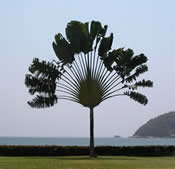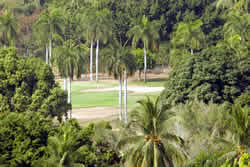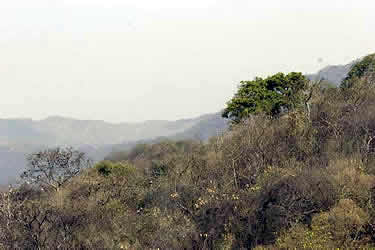Flora of Acapulco
The whole coastline is pretty much devoted to palm trees. There is the ubiquitous Coconut Palm, one of the best plants that has ever come along. The fruit yields oil, the fiber provides matting, and the leaves offer a great roofing material. It is quite a noble specimen. Other palms include the Royal Palms -- the tall, smooth ones in the middle of the Costera Alemán with green trunks. Look for the Bottle Palm and a favorite, the Travelers Palm, which is more of a relative of the banana. Some of these specimens are native to Acapulco, but several others have been imported. But they all flourish here.
Interspersed with the stands of coconut palms are a few mango groves, which bear fruit from April to June. They are not native to the region, but prosper all over the place. Mangos are magnificent trees. The fruit matures at different speeds in various parts of the same tree.

The coastal plain above and around Acapulco is described as a Savanna in the text books. In fact, it is savanna interspersed with large areas of tropical deciduous forest, a good part of which has fallen to the chain saws and machetes of despoilers. In the savanna you will find the gourd tree, whose fruit grows straight out of the trunk, and is about the size of a small melon. It is hollowed out as a water scoop for washing and drinking. The other major feature of the savanna are the mangroves, which grow all around the many lagoons in the area. They are tough, impenetrable and act as a most important protection of the land against the sea. Their exposed roots are an invaluable and impenetrable spawning ground for shrimp, fish, alligators and crocodiles. The trees themselves provide a safe breeding ground for many species of birds.
"Tropical deciduous forest" is informally called "scrub." It is a sort of low jungle that turns brown in the dry season and transforms to a glorious emerald green within a week of the first rains. This terrain requires more rain than savanna.

Another style of landscape is also creeping into Acapulco at a fast pace: Lush green Bermuda grass, elegant palms, small sand dunes and, in winter, green oases in the middle of the arid countryside. Men and women in small, electric carts scurry around it. Four or five such areas have sprung up in Acapulco. This new landscaping anomaly is covered here.
As the traveler moves inland, the mountains continue to rise and the scruffy forest gives way to Pines and Oaks.
These can be found beyond Atoyac, provided that poachers have not chopped them down. These areas are more temperate and provide a home to Mexico's 112 oak species -- both evergreen (Encino) and deciduous -- as well as to 39 species of pine, some with 12-inch needles and others with short stubby ones. Look out for the Ayacahuite, which can grow to 100 feet, and the Ocote Macho, almost as tall, with long gray cones and droopy needles.
The intrepid may want to venture beyond the oaks and pines into the cloud forest. This region begins at about 5,500 feet of altitude. Here the clouds (fog) keep everything damp and soggy. The terrain looks like a prehistoric landscape with tree ferns, bromeliads, orchids, begonias -- all of them adrip with moisture and with lichens on every branch. It is a stark contrast to the parched areas just down the hill.

A word of warning: Travelers to the cloud forest must pass through bandit country. And a variety of illicit crops are cultivated in the mountains of Guerrero. These fields are guarded very, very zealously. If the sentinels suspect a visit from the drug authorities, life as you know it could come to an end.
